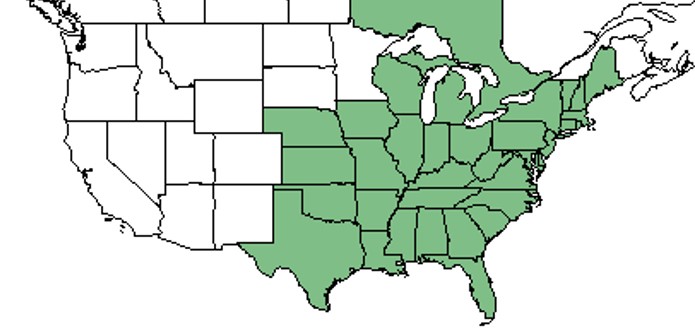Difference between revisions of "Rhus copallinum"
KatieMccoy (talk | contribs) |
KatieMccoy (talk | contribs) |
||
| Line 20: | Line 20: | ||
Common names: Winged sumac, Flameleaf sumac, Shining sumac | Common names: Winged sumac, Flameleaf sumac, Shining sumac | ||
| + | ==Taxonomic notes== | ||
Synonym: ''Rhus copallina'' L. | Synonym: ''Rhus copallina'' L. | ||
| − | + | ||
There are three varieties: ''Rhus copallinum var. copallinum'', ''R. copallinum var. leucantha'', and ''R. copallinum var. latifolia''<ref name="fs">[[http://www.fs.fed.us/database/feis/plants/shrub/rhucop/all.html]]Accessed: March 10, 2016</ref>. | There are three varieties: ''Rhus copallinum var. copallinum'', ''R. copallinum var. leucantha'', and ''R. copallinum var. latifolia''<ref name="fs">[[http://www.fs.fed.us/database/feis/plants/shrub/rhucop/all.html]]Accessed: March 10, 2016</ref>. | ||
Revision as of 14:27, 11 March 2016
| Rhus copallinum | |
|---|---|

| |
| Photo taken by Michelle Smith | |
| Scientific classification | |
| Kingdom: | Plantae |
| Division: | Tracheophyta- Vascular plants |
| Class: | Magnoliopsida – Dicotyledons |
| Order: | Sapindales |
| Family: | Anacardiaceae |
| Genus: | Rhus |
| Species: | R. copallinum |
| Binomial name | |
| Rhus copallinum L. | |

| |
| Natural range of Rhus copallinum from USDA NRCS Plants Database. | |
Common names: Winged sumac, Flameleaf sumac, Shining sumac
Contents
Taxonomic notes
Synonym: Rhus copallina L.
There are three varieties: Rhus copallinum var. copallinum, R. copallinum var. leucantha, and R. copallinum var. latifolia[1].
Description
"Upright shrubs or small trees, not poisonous. Leaves once-pinnately compound. Inflorescence a terminal panicle. Drupes red, ripening in the autumn. Seeds smooth. Flowers produced after the leaves." - Radford et al 1964
"Rhizomatous shrub or small tree to 7 m tall; stems densely short-pubescent. Leaflets 9-23 (mostly 9-11), sessile, oblong to elliptic, 3-8 cm long, 1-4 cm wide, acute to acuminate, entire or less frequently crenate to serrate, base cuneate to rarely rounded, glabrous or densely pubescent beneath; rachis winged. Panicle 0.5-3 dm long and usually as broad. Drupe densely short-pubescent, 3-4 mm broad. Seeds 2.5-3 mm long." - Radford et al 1964
Distribution
Ecology
Habitat
R. copallinum habitats include old fields, oak-hickory woods, oak scrubs, marsh banks, roadsides, and sandridges[2].
Phenology
Seed dispersal
Seed bank and germination
Fire ecology
Pollination
Use by animals
Diseases and parasites
Conservation and Management
Cultivation and restoration
Photo Gallery
References and notes
Radford, Albert E., Harry E. Ahles, and C. Ritchie Bell. Manual of the Vascular Flora of the Carolinas. 1964, 1968. The University of North Carolina Press. 678. Print.
- ↑ [[1]]Accessed: March 10, 2016
- ↑ Florida State University Robert K. Godfrey Herbarium database. URL: http://herbarium.bio.fsu.edu. Last accessed: March 2016. Collectors: Loran C. Anderson, Tom Barnes, Kathy Craddock Burks, G. Fleming, P. Genelle, Robert K. Godfrey, Gary R. Knight. States and Counties: Florida: Florida: Citrus, Franklin, Gadsden, Jackson, Jefferson, Leon, Liberty, St. Johns, Wakulla.